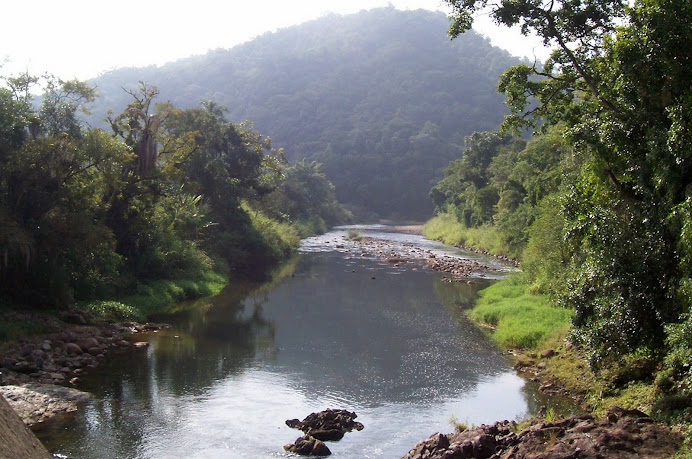
This is a loaded hamburger
consisting of: beef patty, slice
of ham, slice of cheese, bacon,
fried egg, lettuce, tomato,
potato salad (not kidding),
shoestring potatoes (not kidding),
and corn (again, not kidding). Oh, heck, I'm not kidding about any of it.
Brasilians eat a little differently from Americans. This hamburger is a good example. I did choose an all-the-way burger to prove a point. Usually, a regular x-salada (cheeseburger) has only a hamburger patty, slice of ham, slice of cheese, tomato, lettuce, and shoestring potatoes. But basically, the more stuff you can load onto a hamburger bun, the happier the Brasilian. Also, they like their sandwich bun to be finished on a hot press or grill, so every eatery will have one. Another famous sandwich is the Misto Quente (mee-stow ken-tay), which is basically a grilled ham and cheese. A misto is served without any extras, just plain. Don't try and figure it out, you won't be able to.
Brasilians love fried potatoes--batata fritas--and potato sticks--batata palha. I don't recall ever having a meal anywhere where one or both of these aren't served. It is rare to see mashed potatoes or hash browns, but french fries rule in Brasil.
Another interesting eating habit of Brasilians is that they take their drinks in small portions. Usually, a group of people will order a 2-litre bottle of Coke or Guarana (a soda with the herb guarana mixed in) and small glasses. They will take only enough of the drink to take a few sips at a time. They never fill their glasses to the top. Many drink beer the same way. The beer bottles in Brasil are much larger than in the US, so it is typical to order one beer at a time and the table shares that bottle. When it is empty, they order another. Always sharing.
Speaking of sharing, Brasilians share plates of meat at most get-togethers. At a barbeque, for instance, the cook will start grilling sausage, and then progresses to chicken and steak. During the whole cooking process, whatever meat is ready at the time, is placed on a wooden cutting board or platter and bite-size portions are served with toothpicks. The yucca powder I mentioned in an earlier post is served on the platter for dipping. When the chicken and/or steak is ready, it is cut in bite-size pieces and served the same way. Once the initial ritual of eating the meat from the tray is finished, accompanied by much beer and conversation, then the group will sit down to a table filled with side dishes and more meat. It is a wonderful, long process that can take the better part of an afternoon. Come with an appetite though, because about an hour or two after the main meal, dessert dishes come out with coffee and more little finger foods. These folks really know how to eat.
Hygiene is very important to Brasilians as well. When entering a restaurant after a long trip in a car, they will immediately go to the restroom and wash their hands. Some older Brasilian ladies carry washcloths in their purses to wash up before a meal. And after a meal, it is not uncommon to see women in the restroom brushing their teeth. I remember my first trip to Brasil on the airplane. Upon waking up after the overnight flight, breakfast was about to be served. When we first boarded the plane, we were given a pack of goodies, including an eye mask, slippers, and toothbrush with small tube of toothpaste. I thought it odd. Well, imagine my surprise when after breakfast, there was actually a line to all the restrooms on the plane. Every one of those waiting had that little travel toothbrush and toothpaste in hand, awaiting their turn to "freshen up."
These are things I remember about Brasil that endear me to the people. I hope you enjoy these stories, because I will continue remembering through this blog.
Till then, ciao!



































 A little over an hour’s drive from where we lived in Brasil, is an area of beaches that is absolutely stunning. I have collectively called this Bombinhas, but each little stretch of beach carved out of the ocean has its own name. We spent an entire day in this area a couple of times and it is well worth it. There is so much beauty, from the top of the hills looking down into protected coves, to the palm tree infested beaches, to the sparkling aquamarine waters, nothing is more relaxing and refreshing than this area of Santa Catarina.
A little over an hour’s drive from where we lived in Brasil, is an area of beaches that is absolutely stunning. I have collectively called this Bombinhas, but each little stretch of beach carved out of the ocean has its own name. We spent an entire day in this area a couple of times and it is well worth it. There is so much beauty, from the top of the hills looking down into protected coves, to the palm tree infested beaches, to the sparkling aquamarine waters, nothing is more relaxing and refreshing than this area of Santa Catarina.









 Photo 1: Cafe da manha (Breakfast)
Photo 1: Cafe da manha (Breakfast)









